Cattle panel greenhouse plans offer a cost-effective, durable solution for gardeners seeking affordable, sustainable structures․
Using cattle panels, you can build a sturdy, weather-resistant greenhouse to extend the growing season․
These plans are ideal for DIY enthusiasts, providing step-by-step guides for easy construction․
Perfect for small or large spaces, they promote eco-friendly gardening practices and year-round productivity․
What Are Cattle Panel Greenhouses?
Cattle panel greenhouses are cost-effective, durable structures made from repurposed livestock fencing․
These metal panels, originally designed for containing cattle, are ideal for creating a sturdy greenhouse frame․
They are lightweight, rust-resistant, and easy to assemble, making them perfect for DIY projects․
Covered with plastic or poly film, they provide excellent protection for plants year-round․
This budget-friendly option is gaining popularity among gardeners seeking affordable, low-maintenance solutions․
Benefits of Using Cattle Panels for Greenhouses
Cattle panels offer a budget-friendly alternative for building greenhouses, providing excellent durability and versatility․
Their open design allows for natural light and airflow, promoting healthy plant growth․
Easy to assemble and adaptable to various sizes, they suit both small and large spaces․
Additionally, they are rust-resistant and long-lasting, making them a practical choice for gardeners․
Using cattle panels also reduces construction time, allowing for quick setup and immediate use․
Overall, they provide a sustainable, cost-effective solution for extending the growing season․
Materials Needed for a Cattle Panel Greenhouse
Essential materials include cattle panels, steel rebar, wood boards, and heavy-duty zip ties for a sturdy and durable greenhouse structure․
Cattle Panels and Their Specifications
Cattle panels are typically 50 inches wide and come in various lengths, making them ideal for constructing greenhouse frames․
They are durable, weather-resistant, and provide excellent structural support․
Each panel is made of heavy-duty steel, ensuring longevity and stability․
For a standard greenhouse, 4 uncut panels can create a 16×8 foot structure․
They are often coated for UV protection and come in different gauges for varied strength needs․
Framing Materials and Tools Required
Building a cattle panel greenhouse requires essential materials like steel rebar, heavy-duty zip ties, and wooden boards for the base․
Tools include a drill, screwdriver, and wire cutter for assembly․
Additional materials such as UV-stabilized zip ties ensure durability․
Wood boards (12×6 feet) provide a sturdy foundation․
Optional elements like plastic sheeting for covering can enhance functionality․
These materials and tools ensure a stable and functional greenhouse structure․
Additional Components for Stability and Functionality
For enhanced stability, consider adding reinforced brackets or corner connectors to secure the panels․
UV-stabilized plastic sheeting or polycarbonate panels can cover the structure, providing weather protection․
Ventilation systems, such as automatic openers or manual windows, regulate temperature and humidity․
Irrigation kits or drip systems improve plant care efficiency․
Optional shelving or trellises maximize space for plants․
These components ensure the greenhouse is both durable and functional, supporting optimal growing conditions․
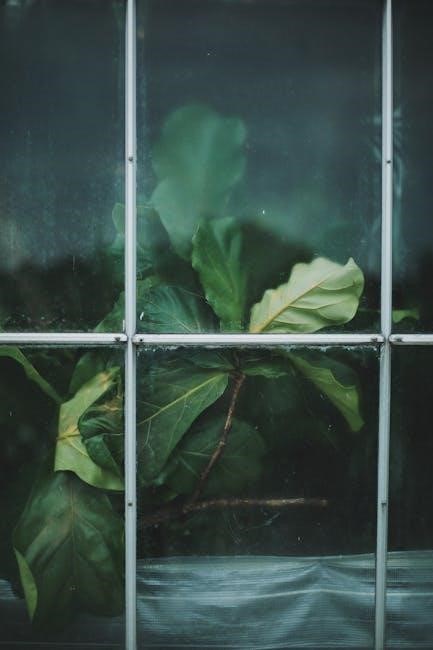
Cost Considerations and Budgeting
Building a cattle panel greenhouse is cost-effective, with materials costing between $300 to $800․
DIY options are more budget-friendly than pre-fabricated kits․
Long-term savings come from reduced heating and extended growing seasons․
Initial investment pays off through increased crop yields and durability․
Estimated Costs for Materials
Building a cattle panel greenhouse is budget-friendly, with material costs ranging from $300 to $800․
The average cost for cattle panels is $20 to $30 each, depending on size and quality․
Steel rebar, zip ties, and lumber add approximately $100 to $200․
Optional materials like plastic covering or irrigation systems increase costs by $50 to $150․
Total expenses remain affordable compared to traditional greenhouses․
These estimates vary based on greenhouse size and location․
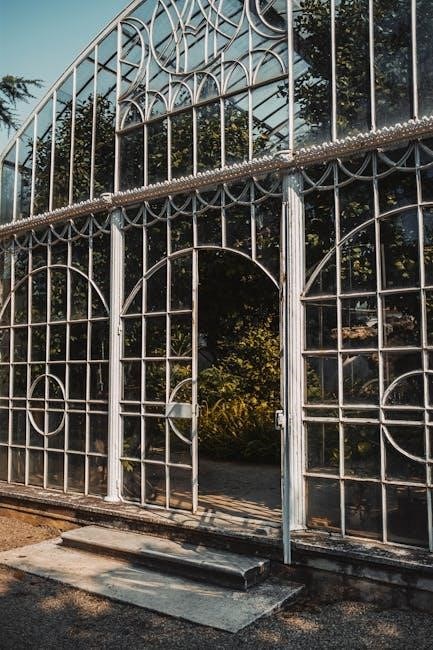
Comparing DIY vs․ Pre-Fabricated Options
DIY cattle panel greenhouses are cost-effective, with materials costing $300–$800, while pre-fabricated options range from $800–$1,500․
DIY offers customization and savings but requires time and effort․
Pre-fabricated greenhouses are quicker to assemble and durable but more expensive․
Both options provide similar functionality, with DIY being ideal for budget-conscious builders and pre-fabricated suiting those seeking convenience․
The choice depends on your priorities, such as budget, time, and desired features․
Step-by-Step Guide to Building a Cattle Panel Greenhouse
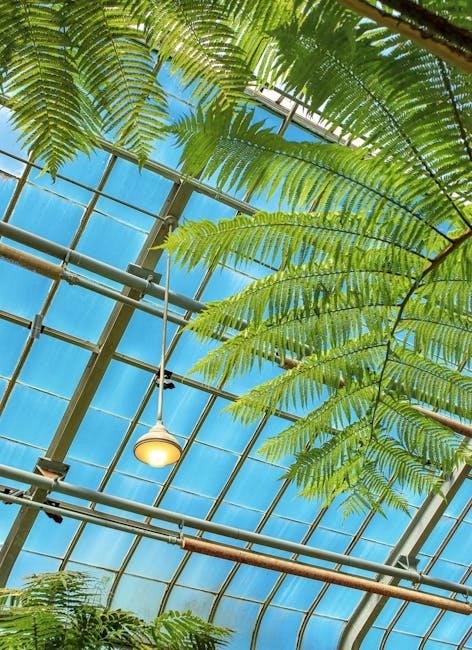
Begin by preparing the site, then assemble the frame using cattle panels and rebar․ Secure the structure with zip ties and add a roof for completion․
Preparing the Site and Foundation
Start by clearing the land of debris and leveling the ground to ensure even placement․ Choose a spot with ample sunlight and proper drainage․ Mark the area using stakes and string to outline the greenhouse dimensions․ Lay down landscaping fabric to prevent weeds and improve drainage․ Compact the soil or gravel base for stability․ Finally, assemble the base frame using wood boards and secure it with rebar, ensuring a solid foundation for your cattle panel greenhouse․
Assembling the Frame and Panels
Begin by attaching the cattle panels to the base frame using heavy-duty zip ties․ Ensure the panels are tightly secured and evenly spaced․ Drill pilot holes for rebar stakes at the base to anchor the structure․ Stand the panels upright, connecting them with UV-stabilized zip ties to form the hoop shape․ Use additional rebar to reinforce the frame at the top and sides․ Make sure the panels are aligned and securely fastened to create a sturdy, weather-resistant structure․ Tighten all ties and double-check the alignment for stability․
Securing the Structure with Zip Ties and Rebar
Use UV-stabilized zip ties to attach cattle panels to the frame, ensuring a snug fit․ Drive rebar stakes into the ground at each corner and along the sides, securing the base․ Additional rebar can be placed horizontally across the top of the panels for added strength․ Tighten all zip ties firmly and wrap excess around the frame for a neat finish․ This method ensures the greenhouse remains stable and withstands harsh weather conditions․ Proper securing is crucial for long-term durability and structural integrity․

Advantages of Cattle Panel Greenhouses
Cattle panel greenhouses are durable, cost-effective, and easy to assemble․ They provide excellent weather resistance and can be built using recycled materials, making them an eco-friendly option․
Durability and Longevity
Cattle panels are made of sturdy steel, ensuring long-lasting durability against harsh weather conditions․ Their robust structure withstands heavy snow and strong winds, making them ideal for year-round use․
With proper installation and maintenance, these greenhouses can last for decades, providing consistent protection for plants․ The UV-stabilized zip ties and rebar further enhance structural integrity, ensuring the greenhouse remains stable and secure over time․
Cost-Effectiveness and Easy Maintenance
Cattle panel greenhouses are a budget-friendly option for gardeners, offering significant savings compared to traditional structures․
With initial costs as low as $350 for a 7․5×22 hoop house, they provide excellent value․
The use of readily available materials like steel panels and zip ties reduces expenses further․
Maintenance is minimal due to the durable nature of the materials, ensuring long-term savings․
This cost-effectiveness, combined with the ease of DIY construction, makes cattle panel greenhouses an attractive choice for gardeners seeking affordable and sustainable solutions․
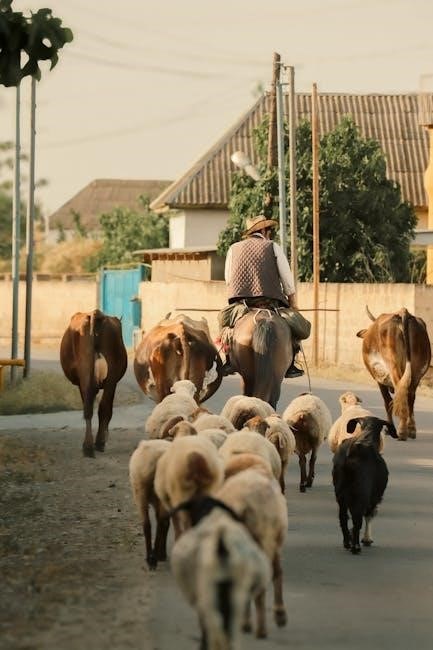
Design Variations and Customization Options
Cattle panel greenhouses offer flexible designs, from small 7․5×22 hoop houses to larger 73×12 structures, catering to various space needs․
Customizable layouts and additional features like ventilation ensure tailored solutions for gardeners․
This adaptability makes them suitable for diverse gardening requirements and preferences․
Different Sizes and Layouts
Cattle panel greenhouses come in various sizes, such as 7․5×22 hoop houses or larger 73×12 structures, offering flexibility for small or expansive spaces․
Layouts can be customized to fit specific needs, whether for backyard gardening or commercial use․
These designs ensure optimal space utilization while maintaining structural integrity․
By adjusting panel lengths and arrangements, growers can create tailored environments for diverse plant varieties․
This versatility makes cattle panel greenhouses suitable for both beginners and experienced gardeners seeking adaptable solutions․
Adding Features Like Ventilation and Irrigation
Enhance your cattle panel greenhouse with essential features like ventilation and irrigation for optimal plant growth․
Ventilation systems can include windows, fans, or automated openers to regulate temperature and humidity․
Irrigation setups, such as drip or sprinkler systems, ensure efficient water distribution․
These additions improve air circulation, prevent overheating, and maintain consistent moisture levels․
By integrating these elements, you create a controlled environment that promotes healthy plant development and maximizes yield․
Such upgrades are often detailed in PDF plans, making implementation straightforward for DIY builders․
Troubleshooting Common Issues
Identify and resolve issues like structural weaknesses or ventilation problems in your cattle panel greenhouse․
Addressing these ensures longevity and optimal growing conditions․
PDF plans often include tips for overcoming these challenges effectively․
Addressing Structural Weaknesses
Structural weaknesses in cattle panel greenhouses often arise from improper panel alignment or insufficient framing support․
Use heavy-duty zip ties and rebar to secure panels tightly, ensuring stability․
A sturdy foundation is crucial to prevent shifting or collapse․
Refer to PDF plans for guidance on reinforcing frames and joints․
Regular inspections can help identify and address potential issues before they escalate․
Adding additional support beams or brackets can further enhance structural integrity․
Ensuring Proper Ventilation and Temperature Control
Proper ventilation and temperature control are essential for a functional cattle panel greenhouse․
Install vents, windows, or shading materials to regulate heat and airflow․
Automated vent openers can help maintain ideal conditions․
Consider adding fans or misting systems for cooling․
Shade cloth can reduce excessive sunlight during summer․
Refer to PDF plans for designs that incorporate these features․
Ensure adequate air circulation to prevent overheating and promote healthy plant growth․
With cattle panel greenhouse plans, you can create a sustainable, durable growing space․
Download comprehensive PDF guides for detailed instructions․
Start building your eco-friendly greenhouse today and enjoy year-round gardening success․
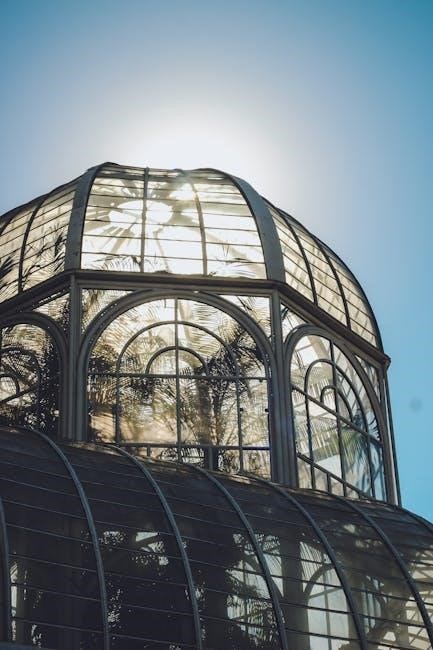
Final Tips for Successful Greenhouse Construction
Ensure panels are tightly secured with zip ties and rebar for stability․
Use UV-stabilized materials to withstand harsh weather conditions․
Prep the site thoroughly to maintain structural integrity․
Follow PDF plans closely for precise measurements․
Consider adding ventilation and irrigation systems․
Regular maintenance will extend the greenhouse’s lifespan․
A well-built cattle panel greenhouse offers eco-friendly, cost-effective gardening year-round․
Accessing PDF Plans and Additional Resources
Detailed PDF plans for cattle panel greenhouses are widely available online, offering step-by-step guides for construction․
These plans often include materials lists, measurements, and assembly instructions․
Downloadable resources provide customizable designs to suit various spaces and budgets․
Online marketplaces like Etsy or specialized gardening websites offer affordable access to these plans․
Additional resources, such as tutorials and forums, can further assist DIY enthusiasts․
These tools ensure a smooth and successful greenhouse-building experience for gardeners of all skill levels․